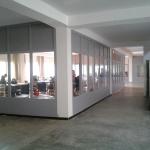Transparent Environment: Is it good or bad?
Primary tabs
I want to speak about the Middle School environment. We speak much about the educational effect of the environment. Maria Montessori says: “The child is educated by the environment that surrounds him”. I have seen the design and completion of the environment which develops the child and corresponds to his/her age at our primary schools: plants, animals, desks and chairs suitable for the learner, large classroom-laboratories, conditions providing the learner's individual activities.... Efforts of many years were needed to turn the Soviet standard nursery school buildings into a world of children's real activities. I had a sort of sense of guilt when, after finishing the primary school programme, the sixth graders moved to the Middle School. Leaving their well-taken care of, colourful, original environment the primary school-children found themselves in a very ordinary area that didn’t have anything to be distinguished. In spite of its partial restorations the Middle School building remained an ordinary soviet school building.
What kind of environment should the Middle School have to be interesting and meet the requirements of the middle school learner’s educational needs and give a chance to be engaged in activities and to develop?
Repairing work was to begin in May 2013, on the eve of the summer camp. What kind of environment do the learners and teachers want? The Middle School declared and organized a contest-discussion for the repairs and restoration work. The teachers and learners gave various suggestions: from different wall illustrations to overlaying the ceilings with mirrors. It may be interesting. But is it the learner developing? The solution was given unexpectedly. At first all the partitions were pulled down: no walls no wall illustrations. That was our chief constructor Mr. Bleyan’s pre-pulling down project. The second floor became an enormous open wide light arena. It was hard to imagine that partitions and walls absorb so much light. Believe me, every partition seemed to be pointless and useless. Intrusion of light and sun gave another charm to the area. We imagined a free working area with learners and teachers engaged in activities. We began the first of September just like that: an enormous laboratory without walls where 120 learners were working. Can't you imagine? It was worth seeing. That area had never been so quiet and favorable for work. Sometimes the teachers, who were passing by the area, were surprised at gentle and quiet hum which never turned into a noise. Mr. Gevorg Hakobyan said, “Have you noticed that there is not any noise?” It was obvious. But it turned out that voice spreads and weakens in an open area and that causes unnecessary tension and tiredness. That was the teachers' complaint. Surprising as it was we didn't get any complaint from the learners, at least I didn't get any. But the teachers' complaint was enough: there was a problem, and it was to be solved. The solution and realization weren't late. The areas were separated with glass partitions. There appeared six educational areas on the second floor. Voices weren't weakened in the areas with glass partitions. The problem was solved.
Transparency caused the most interesting result. The discipline category went up abruptly. It turned out that openness has also a regulatory feature. There can be different violations of school regulations with walls closing everything. Being not visible to public gives such an opportunity: you are with your teacher and classmates, you may misbehave a little, nobody else will see, nothing will happen… But with glass walls you are open to public eye. Both the teacher and the learner are visible: when you raise your voice you are heard and seen from everywhere. If you are reproached and made to stand up, the learners and teachers from other classrooms look at you. Public control and sense of responsibility before community begin to work. You are no longer a closed system and won't hide behind the four walls. There have been cases when the learners are seen to work quietly without their teacher. Do you imagine what would happen in a closed area without the teacher? Having proved itself righteous this approach was also realized on the third floor of the Middle School. The whole Middle School became transparent, visible and open. We no longer have north faced dark and cold classrooms which caused problems especially in autumn and winter. The sun rays and light is for the whole area and the established warmth is the same in every corner.
Transparency enabled us to use the corridors effectively. They became educational areas for the groups of learners who perform separate tasks and yet they are still under the control of their teachers because they are visible. The Middle School now has less pointless running and interval jostle: the glass environment is binding and dictates an appropriate behavior. I confess I didn’t expect such a result.
Let me also speak about the sizes of the educational areas now: the surface of each cabinet is nearly 70 square meters. Small areas, with desks one after another, are really convenient when all the learners are doing the same work, and the teacher is in the center always speaking and explaining something. With teacher-centered method smallness serves to achieve the aim. But to actualize activities, when one group may hold a discussion, the other can work silently, and individual learners perform separate tasks, a large free area becomes a vital necessity. I intentionally mentioned the corridors as educational areas. In case of appropriate organization the club- reading-hall becomes an educational area for club meetings where the club supervisor- reading-hall librarian controls the work of learners' groups. Today it is difficult to find an area in the Middle School which is not educational. The three-storeyed building is an enormous, open, transparent, light educational area. And that is good.

